Published on: 11/01/2022
While you’re likely used to following a run training plan, do you have a plan for recovery?
When you’re trying to balance a job, a family, training for a race, and a social life, it’s easy to ignore the recovery process. After all, it’s just one more thing you have to do. But if you knew that proper recovery could help you feel better while reaching your running goals, you’d make it a priority, right? We thought so.
To get you started, we’ve put together 9 proven ways to recover faster between runs.
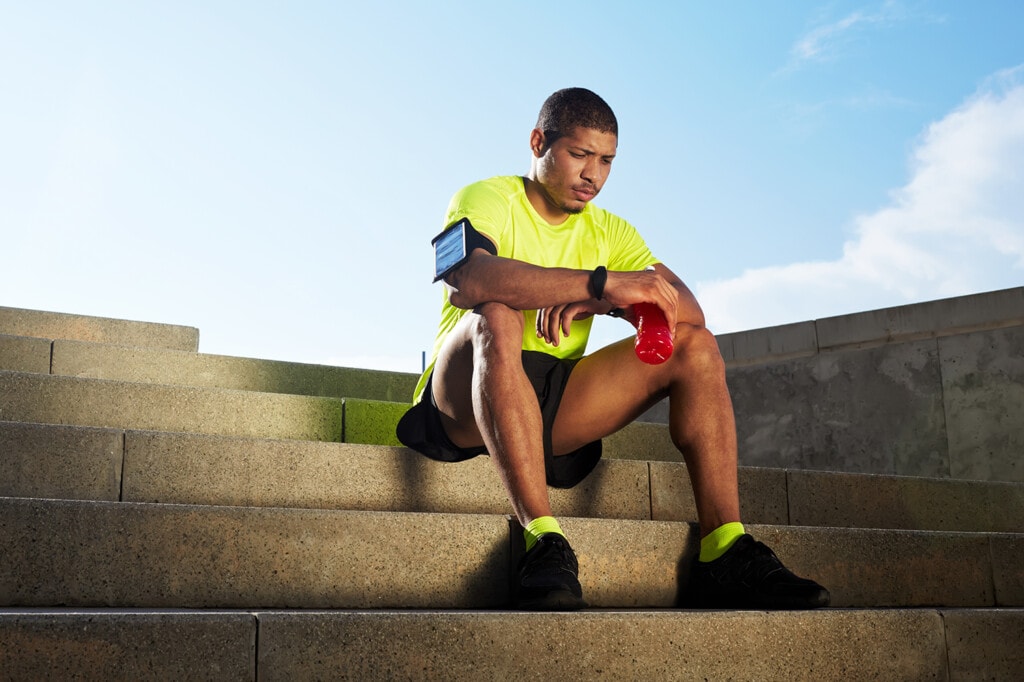
The Importance of Post-Run Recovery
As a runner, you’ve probably experienced heavy legs, sore muscles, fatigue, or runs that just feel harder than they should. Left unchecked, these overtraining symptoms can cause you to miss runs and ultimately derail your marathon training or another big running goal.
One common mistake beginner and experienced runners make is running too soon or too often without taking the time to recover properly. As we’ll explain, this can result in increased inflammation, overuse injuries, delayed onset muscle soreness (DOMS), fatigue, and more. All of this makes it harder to maintain a consistent running schedule.

According to a 2009 study (1), as many as 70% of competitive and recreational long-distance runners experience an overuse injury in the course of a year. Nearly half of these injuries involve the knee, including patellofemoral pain syndrome (PFPS) and iliotibial band syndrome (ITBS). Meniscus injuries and patellar tendinitis are also common.
Nearly all of the remaining injuries, such as shin splints (medial tibial stress syndrome), plantar fasciitis, and Achilles tendinitis, occur below the knee. None of this is good news for runners.
There is good news, though: evidence-based recovery techniques can help you reduce fatigue and soreness and prevent overuse injuries.
Want to increase your chances of running consistently and staying injury-free? Keep reading for our top running recovery tips.
How Recovery Works
Running involves repetitive, high-impact leg movement. This causes muscle damage and depletes your body’s glycogen stores, both of which lead to inflammation. In fact, a 2016 study (2) showed that runners had higher levels of inflammation after a marathon or half-marathon. And the more miles they ran, the higher their inflammation markers were.
While this might sound concerning, inflammation and muscle damage are simply the way our bodies respond to physical activity. And it can be repaired after a run or workout with proper recovery.

Running and other forms of exercise are stressors on the body. Research shows (3) that when we run, muscle fibers are damaged, inflammation develops in other tissues, and we feel fatigued.
Recovery is when our bodies repair and adapt to the stress of exercise. Running recovery aims to reduce fatigue and prevent painful muscle and inflammation. This can help you stay injury-free and ready to take on your next run.
9 Proven Ways to Recover Faster
1. Make easy days easy
Logically, we know that running at an easier or slower pace is going to put less physical strain on our bodies. In fact, research shows (4) that exercising at low intensity (40% of VO2 max) doesn’t increase cortisol levels. And it actually lowered the cortisol of some subjects.
As you’re likely aware, cortisol is the stress hormone. It’s been shown (4) to increase blood pressure and negatively impact metabolism, among other concerns.
Yes, it can be difficult to run easy. But even marathon record-holder (5) Eliud Kipchoge reportedly incorporates recovery runs into his training program.
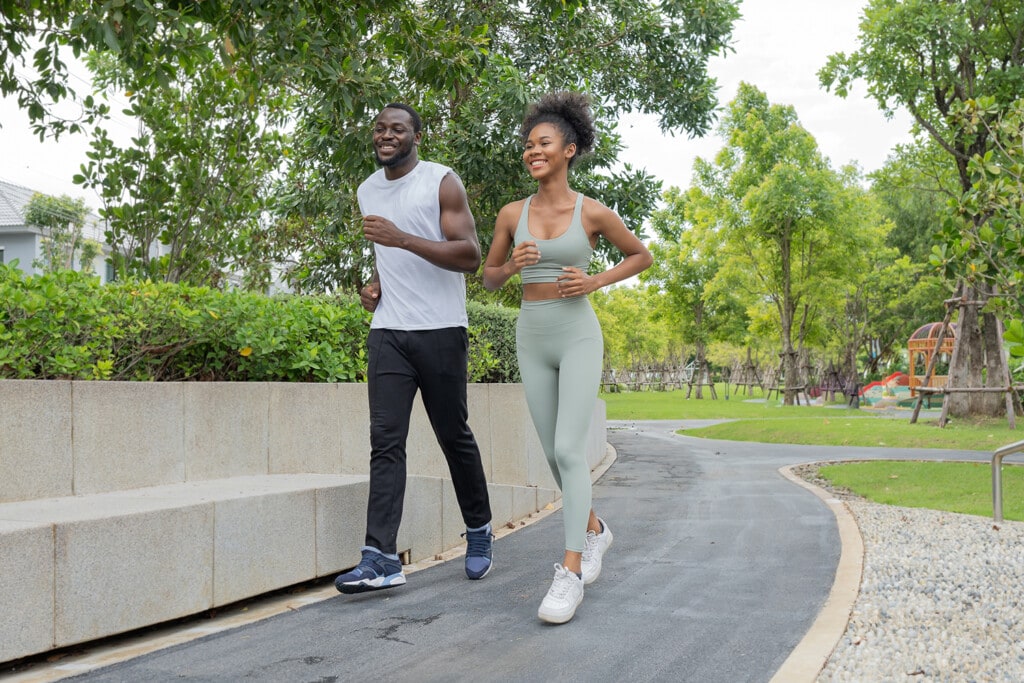
If you have a tough time backing off your pace on easy runs, keep in mind that going at a slower pace will create less stress on your body. And with less stress comes less needed recovery time.
Similarly, be sure to rest on your rest day. Continuing to train without adequate rest has been shown (6) to lead to overtraining syndrome with fatigue and decreased performance. But rest assured (pun intended), honoring your planned rest days will give your body time to rebuild and recover.
If you struggle with taking a rest day, make them days for self-care or doing activities that boost your mental health.
Active recovery days can also be useful for recovery. Gentle yoga (which has been shown (7) to lower cortisol levels), an easy bike ride, or a short walk are good active recovery examples.
Check out the Galloway Method (Run-Walk-Run) to embed recovery more effectively in your training.
2. Rehydrate after workouts
You probably know the importance of staying hydrated during your workouts and even having a favorite sports drink. But post-workout hydration is just as critical. As you know, our bodies use water for good blood flow for repairing muscle, digesting food, and delivering nutrients to our tissues.

As we sweat, we lose both fluid and sodium. In 2019, researchers found (8) that marathon runners lost an average of 85 ounces of fluid, or more than half a gallon, during the race. Additionally, they lost an average of 2.3 grams of sodium, and some even lost up to 7 grams. This fluid and sodium need to be replaced, ideally through a sports drink or recovery drink.
Drinking plain water is a good start. For workouts over 90 minutes or in hot weather, replace electrolytes lost in sweat with sports drinks, coconut water, or even water with a bit of sea salt.
Figure out your sweat loss
An easy way to find out how much you sweat out during your workout is to weigh yourself naked before your run and again afterward. Find the difference and add the number of ounces of fluid you drank during the session. This will tell you how much water you lost.
Make sure you’re drinking enough to replace the fluid lost in sweat during your workouts. For example, if you lose 10 ounces on a 60-minute run, you’ll need to drink 10 ounces of water or an electrolyte drink each hour to maintain your body’s hydration levels.
3. Replenish glycogen stores
It’s far too easy to finish a run and then move on to the next item in your busy schedule without taking time to eat. But eating a post-run snack can help your body replenish the essential nutrients it needs to rebuild and repair muscles from the stress of training.
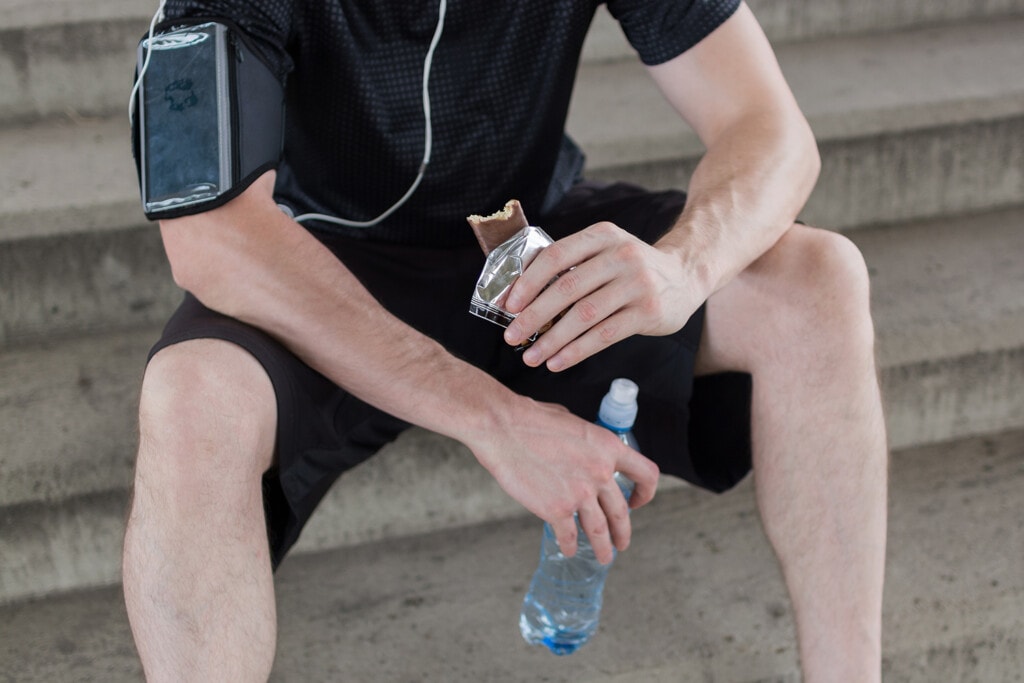
Our muscles use glycogen for fuel during exercise, and it needs to be replaced after a run so the body will be ready for the next workout. In fact, a 2010 study (9) showed that more than 40 percent of marathon runners experienced limited performance due to depleted glycogen.
But reduced energy stores aren’t just a problem for those training for a marathon. In a 2018 study (10), researchers found that glycogen stores start depleting with as little as 45 minutes of exercise.
It’s important to start replenishing muscle glycogen as soon as possible after a workout. Studies show (11) that consuming carbohydrates soon after exercise helps speed up muscle glycogen synthesis. To make it a habit, consider eating a snack while taking a short walk to cool down.
4. Eat protein
To ensure proper recovery, make sure to eat protein with your carbohydrates. A 2020 study (12) found that endurance athletes who consumed 30 grams of protein after endurance exercise had increased muscle recovery. Additionally, it may help muscles respond to endurance activities better in the future. The benefits were found to be greatest when consumed within 20 minutes to a half hour after exercise.

Nine amino acids (13) help with muscle protein synthesis. Complete protein sources have all nine essential amino acids, while incomplete protein sources don’t. Choose eggs, dairy, poultry, fish, tofu, beef, tempeh, or dairy when possible. Several years ago, chocolate milk was at triathlon finish lines everywhere because it contains protein and carbs and is easy to drink on the go.
Have your post-run snack or chocolate milk within 30 minutes, and then follow up an hour or two later with a balanced meal containing protein, fat, and carbs.
5. Foam roll
The foam roller is one recovery tool runners often love to hate. It can feel uncomfortable, but we know we need to use it to loosen sore or tight muscles.
How does foam rolling help with recovery? Fascia is a thin sheet of material that covers our muscles and other tissues. It becomes tight and stiff after a long or strenuous run. This leads to a reduced range of motion in the joints and DOMS or delayed onset muscle soreness.
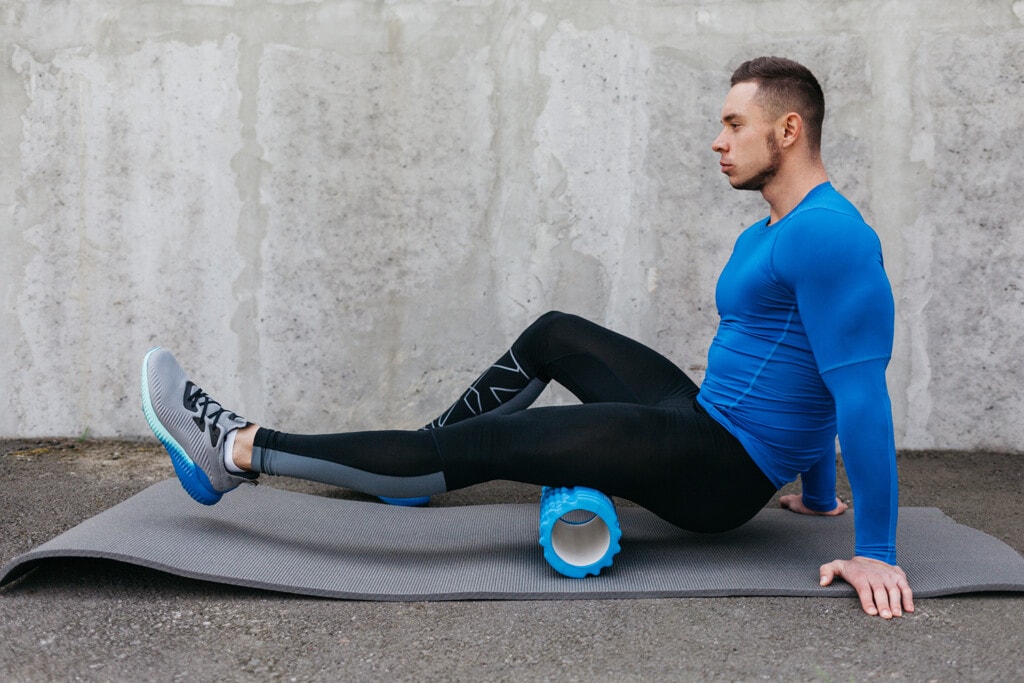
The good news is that a 2015 study (14) found that foam rolling helps improve performance, muscle recovery, and even joint range of motion.
You can use a foam roller to smooth and relax the fascia, a process called myofascial release. After your run, use your roller for five to 10 minutes, focusing on the lower body. You can do this both before and after a run. Be sure to roll out your quads, glutes, and calves to help with sore and stiff muscles. Foam rolling the upper and lower back can help ease tension, too.
6. Stretch
It can be tempting to hit the shower and get on with your day as soon as you finish your workout. But spending even five minutes stretching and doing a cool down after every run can help you speed up recovery and prevent injury.
How?
Studies have shown (15) that a restricted range of motion due to tight muscles leads to injuries. This is because the gait changes to make up for the muscle tightness.
However, stretching has been shown (16) to increase blood flow, which helps speed recovery by filtering out lactic acid. This metabolic byproduct is often cited (17) as the cause of the burn you feel in your muscles after a tough workout and plays a role in sore muscles.
Regular stretching has also been found (18) to increase range of motion (ROM), allowing runners to run with a more natural gait.
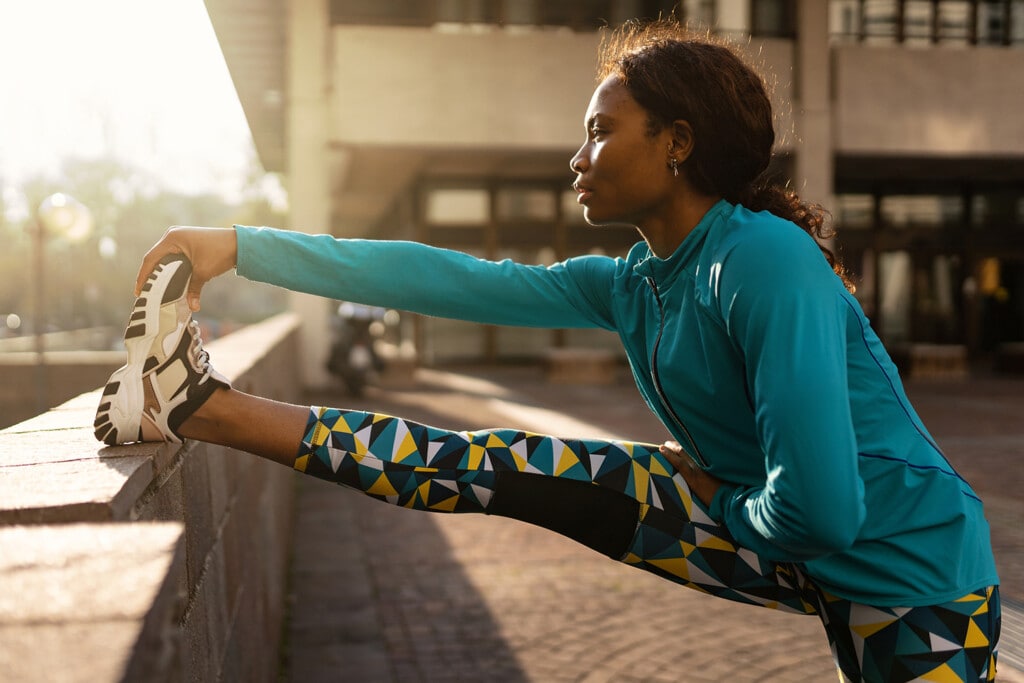
Start your stretching routine with a cool-down consisting of a few minutes of walking or other low-intensity movements at the end of your run. This will give your heart rate, blood pressure, and body temperature a chance to start coming down.
After your cool down, spend a few minutes stretching before you call it a day. As you’ve read, maintaining a post-workout stretching routine after every run will help improve your running performance and reduce your chance of injury.
7. Get enough quality sleep
Nothing tops sleep when it comes to recovery and muscle repair (19). But for amateur athletes who are trying to balance running with work, family, and social life, bedtime isn’t always a priority.
If you need a reason to go to bed earlier, consider this: a recent study (20) found that sleep deprivation caused the participants to run slower. The lack of sleep also increased their rate of perceived exertion, meaning the run felt harder.
Additionally, a 2011 study (19) revealed that lack of sleep reduces levels of insulin-like growth factor (IFG-1) and testosterone, two essential anabolic hormones needed for recovery. It also causes the stress hormone cortisol to spike.

According to the National Sleep Foundation (21), we need seven to nine hours of sleep every night. Signs you may need more sleep include feeling burned out, constantly tired, or like you’re never fully recovered after a workout.
Set yourself up for a night of quality sleep with an evening wind-down routine. Choose soothing quiet activities like gentle stretching, reading, and limiting screen time. If you still struggle to get enough sleep, even a 15 or 20-minute nap during the day can help you feel more rested and alert.
8. Take ice baths or Epsom salt baths
Water immersion has been shown (22) to reduce fatigue and speed up post-run recovery in elite athletes. However, there’s not really a consensus on which type of water immersion therapy is best: cold water (ice bath), hot water, contrast water therapy (alternating hot and cold), and thermoneutral.
Studies show (23) that cryotherapy through an ice bath (cold water immersion) after exercise can help prevent and relieve sore muscles after exercise.
Despite the reputed benefits, many runners avoid ice baths because of the shock of sitting in a tub of ice water. So, here’s a tip to make an ice bath more bearable: fill the bathtub with cool water up to your hips, so your legs are covered, and then add ice. The water will feel less shocking when you get in, and the cold won’t be as noticeable when the ice is added.
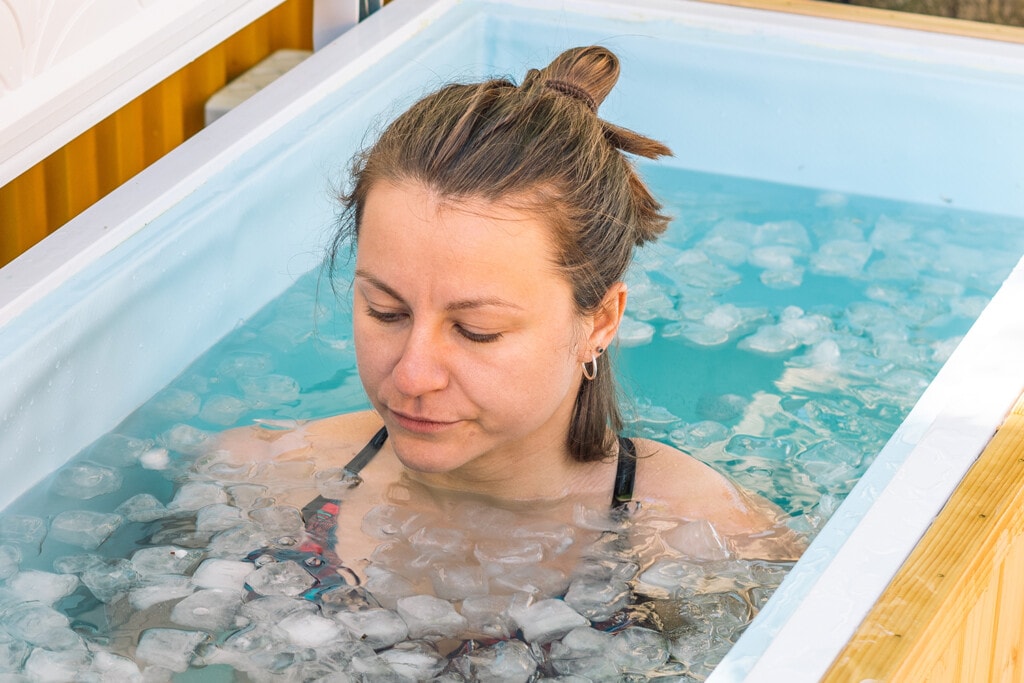
It’s the same idea as boiling a frog by heating the water gradually rather than throwing the frog into a pot of boiling water. The frog won’t notice the water being heated gradually, so it happily stays in the pot. (And unfortunately gets cooked, but you get the idea.)
Many runners also swear by Epsom salt baths for muscle recovery after a hard workout. As previously stated, there is evidence that hot water immersion helps with post-workout recovery. And while there’s no clear scientific evidence that Epsom salt has an effect on recovery, it can be a soothing way to relax after workouts.
Whether you prefer an ice bath or an Epsom salt bath, as referenced above, water immersion can affect recovery in a positive way.
9. Be mindful of how you spend the rest of your day
Your workout is a fraction of your day, so consider what you’re doing the rest of the day, not just immediately after your run. Stay hydrated, fuel your body and get more rest if you need to. It can be tempting to lounge on the couch all day after a long run but try some active recovery to keep your muscles moving.
Also, pay attention to how you’re feeling after your run. You might find that you need an extra snack or a short nap to get you feeling your best and ready to run again.

Create Your Own Recovery Plan
Now that you know the best ways for faster running recovery, you can implement these tips into your routine after every run. Your ideal recovery plan might look different from your training partner’s, and that’s okay. Choose the techniques that work for you, and don’t hesitate to switch them up if needed.
Keep in mind recovery is especially important if you’re doing two training sessions in one day because your recovery time is short. It will get your body ready to perform when it’s time for the second session. Whether you’re doing two runs, a run with strength training, or cross-training and a run, use the recovery techniques in the article between sessions and after your final workout of the day.
A recovery plan might not seem like a priority when you’re already busy, but as you’ve read, you’ll reap the rewards of faster recovery and fewer injuries.
References
Suspected Mechanisms in the Cause of Overuse Running Injuries
Ferber R et al. (2009)
Sports Health
https://www.ncbi.nlm.nih.gov/pmc/articles/PMC3445255/
Acute Changes in Inflammatory Biomarker Levels in Recreational Runners Participating in a Marathon or Half-Marathon
Niemelä M et al (2016)
Sports Med Open
https://www.ncbi.nlm.nih.gov/pmc/articles/PMC5005625/
An Evidence-Based Approach for Choosing Post-exercise Recovery Techniques to Reduce Markers of Muscle Damage, Soreness, Fatigue, and Inflammation: A Systematic Review With Meta-Analysis
Dupuy O et al. (2018)
Front Physiol
https://www.ncbi.nlm.nih.gov/pmc/articles/PMC5932411/
Exercise and circulating cortisol levels: the intensity threshold effect
Hill EE et al. (2008)
J Endocrinol Invest
https://pubmed.ncbi.nlm.nih.gov/18787373/
npr (retrieved on 11/01/2022)
https://www.npr.org/2022/09/25/1124986817/eliud-kipchoge-world-record-berlin-marathon
Body composition, metabolism, sleep, psychological and eating patterns of overtraining syndrome: Results of the EROS study (EROS-PROFILE)
Cadegiani FA et al. (2018)
Journal of Sports Sciences
https://www.tandfonline.com/doi/full/10.1080/02640414.2018.1424498
Cortisol and antidepressant effects of yoga
Thirthalli J et al. (2013)
Indian J Psychiatry
https://www.ncbi.nlm.nih.gov/pmc/articles/PMC3768222/
The Role of Volume Regulation and Thermoregulation in AKI during Marathon Running
Sherry G et al. (2019)
CJASN
https://cjasn.asnjournals.org/content/14/9/1297
Metabolic Factors Limiting Performance in Marathon Runners
Rapoport BI (2010)
PLoS Comput Biol
https://www.ncbi.nlm.nih.gov/pmc/articles/PMC2958805/
Fundamentals of glycogen metabolism for coaches and athletes
Murray B et al. (2018)
Nutr Rev
https://www.ncbi.nlm.nih.gov/pmc/articles/PMC6019055/
Regulation of Muscle Glycogen Repletion, Muscle Protein Synthesis and Repair Following Exercise
Ivy JL (2004)
J Sports Sci Med
https://www.ncbi.nlm.nih.gov/pmc/articles/PMC3905295/
Dose-response effects of dietary protein on muscle protein synthesis during recovery from endurance exercise in young men: a double-blind randomized trial
Churchward-Venne TA et al. (2020)
The American Journal of Clinical Nutrition
https://academic.oup.com/ajcn/article/112/2/303/5828186
Biochemistry, Essential Amino Acids
Lopez MJ et al. (Updated 2022 Mar 18)
StatPearls [Internet]
https://www.ncbi.nlm.nih.gov/books/NBK557845/
THE EFFECTS OF SELF‐MYOFASCIAL RELEASE USING A FOAM ROLL OR ROLLER MASSAGER ON JOINT RANGE OF MOTION, MUSCLE RECOVERY, AND PERFORMANCE: A SYSTEMATIC REVIEW
Cheatham SW et al. (2015)
Int J Sports Phys Ther
https://www.ncbi.nlm.nih.gov/pmc/articles/PMC4637917/
The Effect of Calf Stiffness on Gait, Foot Pressure and Balance in Adults
J Kor Phys Ther (2019)
The Korean Society of Physical Therapy
http://www.kptjournal.org/journal/view.html?doi=10.18857/jkpt.2019.31.6.346
Daily muscle stretching enhances blood flow, endothelial function, capillarity, vascular volume and connectivity in aged skeletal muscle
Hotta K et al. (2018)
J Physiol
https://pubmed.ncbi.nlm.nih.gov/29623692/
Scientific American (retrieved on 11/01/2022)
https://www.scientificamerican.com/article/why-does-lactic-acid-buil/
Does stretching induce lasting increases in joint ROM? A systematic review
Harvey L et al. (2002)
Physiother Res Int
https://pubmed.ncbi.nlm.nih.gov/11992980/
Sleep and muscle recovery: endocrinological and molecular basis for a new and promising hypothesis
Dattilo M et al. (2011)
https://pubmed.ncbi.nlm.nih.gov/21550729/
Monitoring Effects of Sleep Extension and Restriction on Endurance Performance Using Heart Rate Indices
Roberts SSH et al. (2021)
https://pubmed.ncbi.nlm.nih.gov/34711770/
National Sleep Foundation’s sleep time duration recommendations: methodology and results summary
Hirshkowitz M et al. (2015)
Sleep Health
https://pubmed.ncbi.nlm.nih.gov/29073412/
Water immersion recovery for athletes: effect on exercise performance and practical recommendations
Versey NG et al. (2013)
Sports Med
https://pubmed.ncbi.nlm.nih.gov/23743793/
Cold‐water immersion (cryotherapy) for preventing and treating muscle soreness after exercise
Bleakley C et al. (2012)
Cochrane Database of Systematic Reviews
https://www.cochranelibrary.com/cdsr/doi/10.1002/14651858.CD008262.pub2/full

